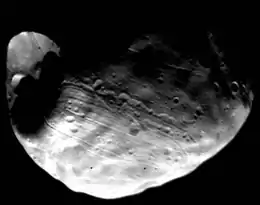Stickney (crater)
Stickney is the largest crater on Phobos, which is a satellite of Mars. It is 9 km (5.6 mi) in diameter, taking up a substantial proportion of the moon's surface.
 Stickney on Phobos (at left) (Viking orbiter, 10 June 1977). | |
| Feature type | Impact crater |
|---|---|
| Location | 1°N 49°W[1] |
| Dimensions | 9 km (5.6 mi) in diameter. |
| Discoverer | Asaph Hall |
| Naming | Chloe Angeline Stickney Hall |

The crater is named after Chloe Angeline Stickney Hall, wife of Phobos's discoverer, Asaph Hall.[1] In 1878 Hall wrote that he "might have abandoned the search [for Martian satellites] had it not been for the encouragement of [his] wife."[2] The crater was named in 1973, based on Mariner 9 images, by an IAU nomenclature committee chaired by Carl Sagan.[3]
Stickney has a smaller crater within it, about 2 km (1.2 mi) in diameter, resulting from a later impact. In 2006 it was given the name Limtoc, after a character in Gulliver's Travels.[4]
Grooves and crater chains appear to radiate from Stickney. These have led to theories about the impact that formed Stickney nearly destroying the moon. However, evidence from the Mars Express orbiter indicate that they are unrelated to Stickney and may have been formed by material ejected from impacts on Mars.[5] More recent modelling supports the theory that the grooves are signs of deformation caused by tidal forces.[6] The crater has a noticeable lineated texture on its interior walls, caused by landslides from materials falling into the crater.[7] Nonetheless, in November 2018, astronomers concluded that the many grooves on Phobos were caused by boulders, ejected from the asteroid impact that created Stickney, that rolled around on the surface of the moon.[8][9]
It is possible that Stickney is large enough to be seen with the naked eye from the surface of Mars.[10] It is located at the middle of the western edge of the Mars-facing side of Phobos.
See also
References
- "Planetary Names: Crater, craters: Stickney on Phobos". Gazetteer of Planetary Nomenclature. Nov 29, 2006.
- Hall, Asaph, Observations and orbits of the satellites of Mars, Washington: Government Printing Office, 1878 (quoted in Hall, Angelo, An astronomer's wife, Baltimore: Nunn and Company, 1908, p. 112).
- Veverka, Joseph; Noland, Michael; Sagan, Carl; Pollack, James; Quam, Lynn; Tucker, Robert; Eross, Botand; Duxbury, Thomas; Green, William (1974). "A Mariner 9 atlas of the moons of Mars". Icarus. 23 (2): 206–289. Bibcode:1974Icar...23..206V. doi:10.1016/0019-1035(74)90006-2..
- "Planetary Names: Crater, craters: Limtoc on Phobos". Gazetteer of Planetary Nomenclature. Mar 1, 2007.
- Murray, John B. et al. "New evidence on the origin of Phobos' parallel grooves from HRSC Mars Express," Lunar and Planetary Science XXXVII (2006).
- Zubritsky, Elizabeth (2015-11-10). "Mars' Moon Phobos is Slowly Falling Apart". NASA's Goddard Space Flight Center. Retrieved 11 November 2015.
- "Phobos from 6,800 Kilometers (Color)". NASA/JPL-Caltech/University of Arizona. 9 April 2008. Retrieved 9 April 2008.
- Gough, Evan (20 November 2018). "Strange Grooves on Phobos Were Caused by Boulders Rolling Around on its Surface". Universe Today. Retrieved 21 November 2018.
- Ramsley, Kenneth R.; Head, James W. (16 November 2018). "Origin of Phobos grooves: Testing the Stickney Crater ejecta model". Planetary and Space Science. 165: 137–147. doi:10.1016/j.pss.2018.11.004.
- Calculating the angular size of an object with a diameter of 9 kilometres (5.6 mi) at a distance of 9,250 kilometres (5,750 mi), yields 9/9250 * 206265 = 200 arcseconds. An object needs a size of 60 arcseconds to be resolved by the naked eye.
External links
| Wikimedia Commons has media related to Stickney (crater). |
- Flight around Phobos (animated movie)
- Stickney in High Resolution
- Stickney at APOD, 2018 May 5
- Creation of Stickney Crater on Phobos (VIDEO) simulation which shows how Stickney crater was created, and how it affected Phobos, The Lawrence Livermore National Laboratory